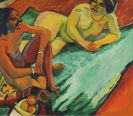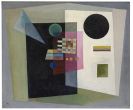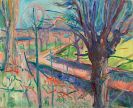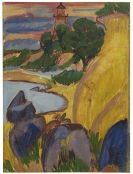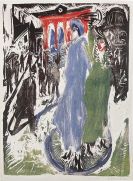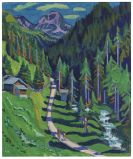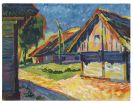
Oskar Kokoschka
Pöchlarn/Niederösterreich
1886 -
Montreux
1980
The Austrian artist Oskar Kokoschka was born in the Lower Austrian town of Pöchlarn in 1886. He receives a state scholarship in 1904 and studies at the School for Applied Arts. During his studies, he designs postcards, fans and vignettes for the "Wiener Werkstätte" (Vienna Workshop).
He partakes in the "Kunstschau" (Art Exhibition), a joint project of the Vienna Secession and the Vienna Workshop. Besides designs for gobelins, he also shows drawings and gouaches of nude girls, which cause a scandal. But the young artist calls the attention of Gustav Klimt and the architect Adolf Loos. Especially Adolf Loos encourages him, he accompanies him on several journeys and also supports him financially.
In 1910 Kokoschka meets Herwarth Walden and the "Sturm-Kreis" (Storm Circle) while staying in Berlin, for whom he works a lot in the following years. He becomes assistant at the Vienna School for Applied Arts in 1912-13 and teaches nude drawing. He meets Alma Mahler, widow of the composer Gustav Mahler in Vienna in 1912, with whom he has a passionate affair until 1915, the end of their relationship gets to him and he becomes depressive.
Kokoschka volunteers in World War I and is dismissed in 1915, as he is severely wounded. In 1919 he is appointed professor at the Dresden Art Academy. The 1920s are years of success for Oskar Kokoschka. The Berlin gallery owner Bruno Cassirer contracts him, which, along with his professorship, gzuarantees a regular income.
Oskar Kokoschka created his best works mostly as portraitist. Regardless of beauty and mimetic resemblance with the person depicted, he achieves a psychological pervasion of his model. As of 1921 he also makes numerous city views.
Kokoschka leaves Dresden after his father's death and does not return, also giving up his professorship. As of 1924 he regularly goes to Paris and on several journeys through Europe, to the Middle East and North Africa. In 1933 he is back in Vienna, however, he soon flees the impending political changes to London. Eight of his works are shown in the exhibition "Degenerate Art" in Munich in 1937. As a reaction, he does the painting "Selbstbildnis als entarteter Künstler" (Self-Portrait as a Degenerate Artist). In 1947 Kokoschka takes on British Citizenship.
Besides his activities as a painter, Oskar Kokoschka also wrote poetry. He publishes his first poetry book "Die träumenden Knaben" (Dreaming Boys) in 1908, for which he also did the illustrations. He writes the one-act play "Sphinx und Strohmann" (Sphiny and Straw Man) and publishes his expressionist play "Mörder, Hoffnung der Frauen" (Murderer, Hope for Women) in the magazine "Der Sturm" (The Storm).
Kokoschka lives in Villeneuve on Lake Geneva after the war. From 1953 to 1963 he is director of the Salzburg Summer Academy "Schule des Sehens" (School of Vision).
Oskar Kokoschka dies in the Swiss town of Montreux on February 22, 1980.
Would you like to sell a work by Oskar Kokoschka?
Infos for seller
